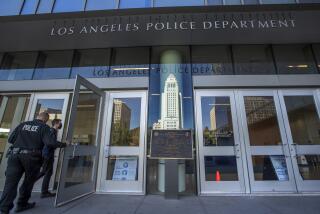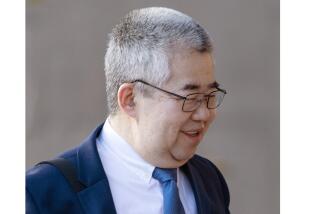38-Year Prison Term Given in Officer Killing
A contrite Hau Cheong (Peter) Chan, convicted of second-degree murder in the 1984 killing of a Los Angeles police officer during a Chinatown robbery attempt, was given a state prison term of 38 years to life Tuesday.
The sentencing by Superior Court Judge Jean Matusinka capped 1 1/2 days of acrimonious wrangling between Chan’s defense attorneys and prosecutor Lawrence Longo over the contents of Chan’s probation report.
That report, still to be completed, would serve as a key document for the state Board of Prison Terms when the time comes to consider Chan for parole, which could occur in about 22 years, according to lawyers in the case.
Archie Nagao, the Los Angeles police officer who was shot but survived the shoot-out, attended Tuesday’s court session, wearing a knit shirt and slacks on a day of vacation. He said Chan’s sentence was “better than nothing.”
Seconds later, as those in the courtroom began to disperse, Officer Nagao and Leslie Abramson, one of Chan’s lawyers, had a sharp exchange that ended with Nagao saying acidly to Abramson, “He’s alive.”
“So are you,” Abramson replied.
“But Duane isn’t,” Nagao answered, referring to his dead partner, Duane Johnson. Nagao then turned and walked out of the courtroom.
Chan had been scheduled for sentencing last month, but Matusinka postponed it after Abramson complained that the probation report contained numerous errors and omissions. Abramson said the report contained “quadruple levels of hearsay going back 12 years.”
Matusinka agreed that the report was “very, very one-sided.” And after sentencing Chan, she ordered the County Probation Department to prepare a new report, with assistance from Longo as well as from the defense.
Lesser Verdict Returned
Chan’s case was controversial from the beginning because Longo had sought a first-degree murder conviction, which could have sent Chan, 32, to the gas chamber at San Quentin. But the jury returned the lesser verdict.
During Chan’s seven-month trial, there was much conflicting testimony that left murky his role in the robbery attempt. Longo contended that Chan was the mastermind, but several jurors said after the April verdict that they believed that Chan had not been inside the store and that, instead, he was the driver of the getaway car.
In the unsuccessful robbery attempt of the Jin Hing Jewelry story on a rainy Dec. 19 nearly four years ago, Chan and an accomplice, San Nam Chinh, were injured during a shoot-out with Nagao and Johnson. Two other accomplices--Robert Woo, 26, and John Cheong, 33--died during the gun battle. The fifth suspect, Thong Huynh, was acquitted of harboring Chinh after the bungled robbery. He then became a witness for the prosecution, testifying about how the robbery was planned.
Officer Johnson was shot and killed at the scene.
Chan also was convicted of attempted murder in the shooting of Nagao and Robert Lee, son of the jewelry store owner, as well as assault with a deadly weapon on Nagao and first-degree robbery.
Chinh, 22, was sentenced in May to life without the possibility of parole. He had been convicted of first-degree murder in Johnson’s death and of the attempted murder of Nagao and Lee.
The robbery attempt was aborted when Leon Lee, owner of the jewelry store on Bamboo Lane in Chinatown, triggered a silent alarm, and Johnson and Nagao responded from a police substation half a block away.
Despite the jury’s findings, the precise details of what took place on that fateful afternoon remain fuzzy--resulting in the prolonged disputes on Monday and much of Tuesday over the contents of Chan’s probation report.
Longo wanted to include testimony of witnesses that buttressed his contention that Chan had been inside the store and that he had been the mastermind of the robbery plot--contentions that Abramson noted had been rejected by the jury.
“I just want (in the report) what certain witnesses testified to,” Longo said.
But Abramson argued that “theories” and “rejected facts” have no place in a probation report.
On these and many other points of contention, compromises were reached. At times during the last 1 1/2 days, as the judge and the lawyers went over the report line by line, word by word, negotiating and haggling, the courtroom scene was more like an exercise in committee editing than a criminal proceeding.
“It’s a joke, isn’t it?” Nagao whispered at one point.
In a letter to Matusinka, Chan reiterated that he had not been inside the jewelry store and that he was not the mastermind.
“I feel very bad and sorry about the whole incident,” Chan wrote. He said he feels “like crying” every time he thinks about Johnson, “who was so young, (and) the pain and suffering that (the incident) caused to his family who will never see him again. . . . I am ready to accept my punishment.”
More to Read
Sign up for Essential California
The most important California stories and recommendations in your inbox every morning.
You may occasionally receive promotional content from the Los Angeles Times.









